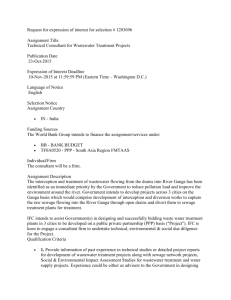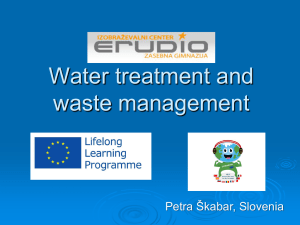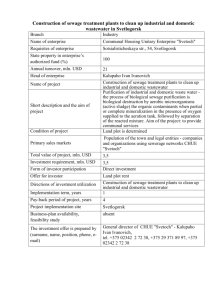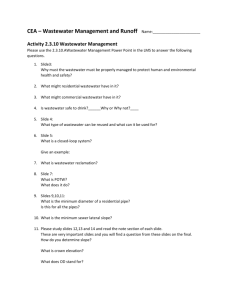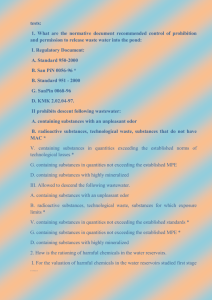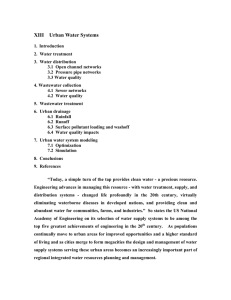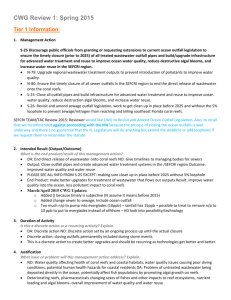Key
advertisement
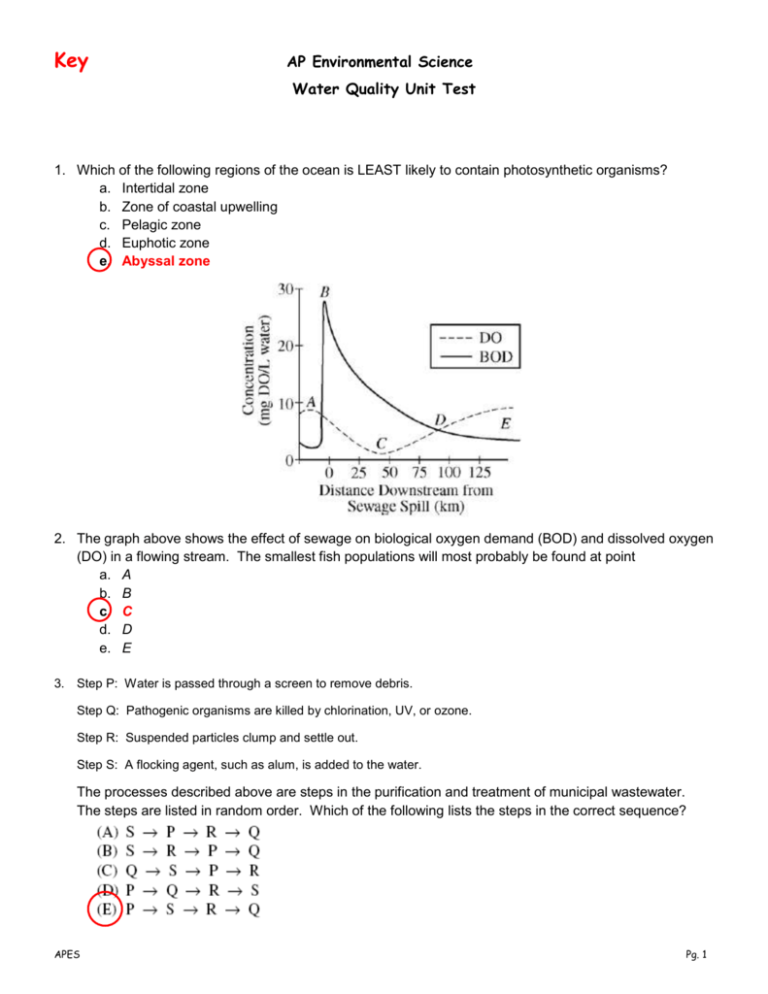
Key AP Environmental Science Water Quality Unit Test 1. Which of the following regions of the ocean is LEAST likely to contain photosynthetic organisms? a. Intertidal zone b. Zone of coastal upwelling c. Pelagic zone d. Euphotic zone e. Abyssal zone 2. The graph above shows the effect of sewage on biological oxygen demand (BOD) and dissolved oxygen (DO) in a flowing stream. The smallest fish populations will most probably be found at point a. A b. B c. C d. D e. E 3. Step P: Water is passed through a screen to remove debris. Step Q: Pathogenic organisms are killed by chlorination, UV, or ozone. Step R: Suspended particles clump and settle out. Step S: A flocking agent, such as alum, is added to the water. The processes described above are steps in the purification and treatment of municipal wastewater. The steps are listed in random order. Which of the following lists the steps in the correct sequence? APES Pg. 1 4. Which of the following is true of sewage treatment plants in the United States? a. They release wastewater before solids are removed from the sewage. b. They use stormwater runoff to assist in the treatment process. c. They are not designed to remove pharmaceutical chemicals from wastewater. d. They have largely eliminated cultural eutrophication in Chesapeake Bay. e. They release wastewater that is not regulated by the Clean Water Act. 5. Waste from which of the following is an example of nonpoint source pollution? a. Overflow from a sewage treatment plant b. Outgassing from a municipal landfill c. Dumping at a food-processing plant d. Drainage from an abandoned mine e. Runoff from agricultural fields 6. Which of the following is an effective alternative to chlorine for disinfecting wastewater in a municipal treatment plant? a. Freon b. Alcohol c. Phosphate d. Ammonia e. Ozone 7. The presence of fecal coliform bacteria in a sample of river water suggests which of the following? a. The pH of the river is very high. b. The water is contaminated with animal waste. c. The river is devoid of plant life. d. The dissolved oxygen level of the river is high. e. Fish caught from the river will be free of parasites. 8. Which of the following components of a wastewater treatment plant is designed to facilitate the decomposition of organic material by aerobic microorganisms? a. Bar screen b. Grit-settling tank c. Activated-sludge tank d. Chlorination tank e. Ultraviolet-light array 9. APES Which method introduces microorganisms to break down hazardous organic compounds? a. Sanitary landfill b. Incineration c. Discharge to sewers, streams and rivers d. Chemical treatment e. Biological treatment Pg. 2 10. Which method would be best suited for neutralizing the acidic components of waste? a. Sanitary landfill b. Incineration c. Discharge to sewers, streams, and rivers d. Chemical treatment e. Biological treatment 11. Of the following, which constitutes the greatest percent of domestic use of water in the United States? a. Flushing toilets b. Drinking c. Cooking d. Washing dishes e. Washing clothes 12. The major biological source of dissolved oxygen in the ocean comes from a. Decomposition of organic sediments on the ocean floor b. Metabolic processes of coral in reefs c. Oxidation of sulfur by bacteria in ocean vent communities d. Photosynthesis by phytoplankton e. Respiration by zooplankton 13. Of the following, which is the best example of a point source of water pollution? a. Factory effluent b. Storm water c. Acid precipitation d. Agricultural runoff e. Residential pesticide runoff 14. In the removal of a pollutant from wastewater, which of the following is true of the cost per unit of pollutant removed? a. It decreases as the toxicity of the pollutant increases. b. It decreases as the time passed before remediation increases. c. It increases as the concentration of the pollutant decreases. d. It increases as the volume of the wastewater decreases. e. It does not change over time or with concentration of pollutant. 15. Which of the following will result in accelerated eutrophication when introduced into streams, lakes and bays? a. Bacteria and viruses b. Pesticides c. Herbicides d. Phosphates e. Acid wastes and salts APES Pg. 3


